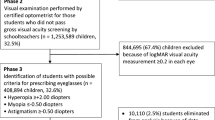Abstract
The purpose of this study was to determine the number of residents requiring corrective lenses in a youth detention center for juveniles from 12 to 18 years old over a 2-year period. A greater number of adolescents incarcerated for criminal activity in a detention center had uncorrected refractive errors (34.87 %) as compared to a comparable population in the public school system (22 %). The prevalence of significant refractive errors among incarcerated adolescents in this study is significantly higher than has been reported previously. The current study found a refractive error rate of almost 35 %. This difference can be explained by a number of factors in their social environments and identifies an area for potential intervention to reduce antisocial behavior in this population.
Similar content being viewed by others
References
Christle, C. A., Jolivette, A., & Nelson, C. A. (2005). Breaking the school to prison pipeline: Identifying school risk and protective factors for youth delinquency. Exceptionality: A Special Education Journal, 13, 69–88.
Ciner, E. B., & Schmidt, P. P. (1996). Vision screening of preschool children: Evaluating the past, looking toward the future. Optometry Vision Science, 75, 571–584.
Dandona, R., & Dandona, L. (2001). Refractive error blindness. Bulletin of the World Health Organization, 79, 1–10.
Dotan, G., Truong, B., Snitzer, M., McCauley, C., Martinez-Helfman, S., Santa Maria, K., & Levin, A. V. (2015). Outcomes of an inner-city vision outreach program give kids sight day. Journal of the American Medical Association Ophthalmology, 133, 527–532.
Festinger, T., & Duckman, R. H. (2004). Vision status among foster children in NYC. Social Work in Health Care, 38, 77–81.
Jobke, S., Kasten, E., & Vorwerk, C. (2008). The prevalence rates of refractive errors among children, adolescents, and adults in Germany. Clinical Ophthalmology, 2, 601–607.
Johnson, R., Nottingham, D., Stratton, R., & Zaba, J. N. (1996). The vision screening of academically and behaviorally at-risk pupils. Journal of Behavioral Optometry, 17, 1–5.
Kleinstein, R. N., Jones, L. A., Hullett, S., Kwon, S., Lee, R. J., Friedman, N. E., … & Zadnik, K. (2003). Refractive error and ethnicity in children. Archives of Ophthalmology, 121, 1141–1147.
Leonard, R. (2002). Statistics on vision impairment: A resource manual. Arelene R Gordon Research Institute of Lighthouse International. April.
Naidoo, K. S., & Jaggernath, J. (2012). Uncorrected refractive errors. Indian Journal of Ophthalmology, 60, 432–437.
Powell, C., Wedner, S., & Hatt, S. R. (2006). Vision screening for correctable visual acuity deficits in school-age children and adolescents. Cochrane Database of Systematic Reviews (2),. doi:10.1002/14651858.CD005023.pub2.
Roberts, J., & Slaby, D. (1974). Refraction status of youths 12-17 years. Vital Health Statistics, 148, 1–55.
Rohul, A. M., Maqbool, A., Hussain, S. A., Shamila, H., Anjum, F., & Hamdani, Z. A. (2013). Prevalence of refractive errors in adolescents in outpatient attendees of the preventive ophthalmology clinic of community medicine, SKIMS, Kashmir, India. Nitte University Journal of Health Science, 3, 7–20.
Villarreal, M. G., Ohlsson, J., Abrahamsson, M., & Sjostrom, A. (2000). Myopisation: the refractive tendency in teenagers. Prevalence of myopia among teenagers in Sweden. Acta Ophthalmologica Scandinavia, 8, 177–181.
Vitale, S., Cotch, M. F., & Sperduto, R. D. (2006). Prevalence of visual impairment in the United States. Journal of the American Medical Association, 295, 2158–2163.
Williams, S., Wajda, B. N., Alvi, R., McCauley, C., Martinez-Helfman, S., & Levin, A. V. (2013). The challenges to ophthalmologic follow-up care in at-risk pediatric populations. Journal of American Association for Pediatric Ophthalmology and Strabismus., 17, 140–143.
Wong, S. (1976). Vision analysis and refractive status of youths in a juvenile detention home population. Journal of Optometry and Physiological Optics, 53, 112–119.
Zaba, J. N. (2001a). Children’s vision care in the 21st century and its impact on education, literacy, social issues, and the workplace: A call to action. Journal of Behavorial Optometry, 22, 39–40.
Zaba, J. N. (2001b). Social, emotional, and educational consequences of undetected children’s vision problems. Journal of Behavioral Optometry, 12, 66–70.
Author information
Authors and Affiliations
Corresponding author
Ethics declarations
Conflict of interest
No financial interests or conflicts of interest for corresponding author or co-authors.
Rights and permissions
About this article
Cite this article
Harrie, R.P., Harrie, P.C. The Prevalence of Uncorrected Refractive Errors in Adolescents Incarcerated in a Youth Detention Center. Child Adolesc Soc Work J 33, 273–277 (2016). https://doi.org/10.1007/s10560-015-0422-4
Published:
Issue Date:
DOI: https://doi.org/10.1007/s10560-015-0422-4




